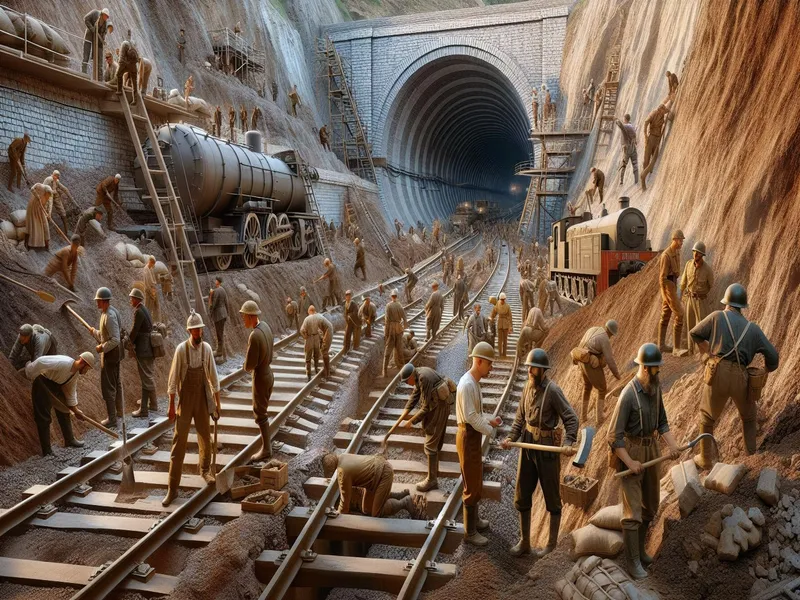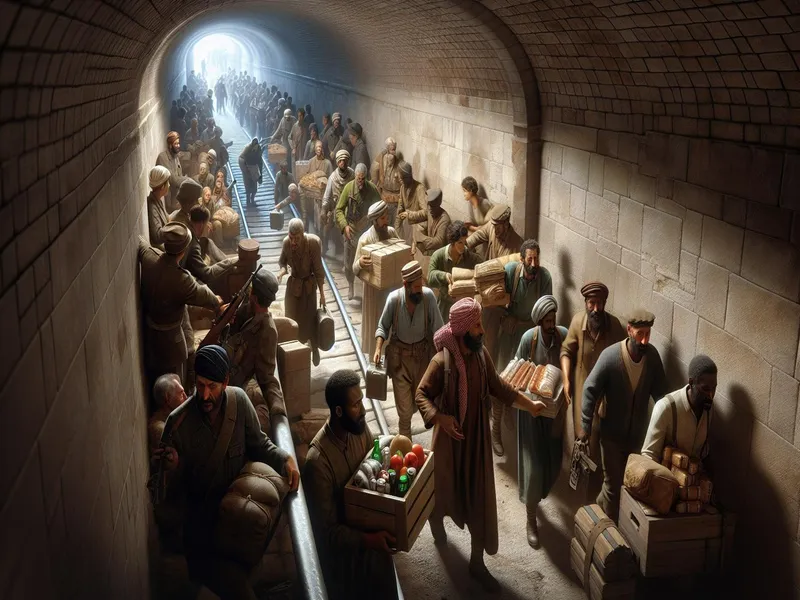the Sarajevo Tunnel’s role in the Bosnian War, a must-see for backpackers. Explore its history, resilience, and visit the museum to connect with local stories.

Historical Background
Hey there, fellow traveler! Let’s jump into the historical backdrop of the Sarajevo Tunnel. This isn’t just any tunnel; it’s a tale of grit and ingenuity.
During the Bosnian War (1992-1995), Sarajevo was under siege for nearly four years. Imagine being in a city cut off from the world, with snipers and shelling all around. Scary stuff, right? The Sarajevo Tunnel, also known as the Tunnel of Hope, was built to connect two neighborhoods—Dobrinja and Butmir—which were separated by enemy lines.
A Lifeline in Dark Times
The builders dug this 800-meter tunnel by hand, using shovels and pickaxes. It took them about six months to complete it in mid-1993. Without modern tools or machines, they relied on sheer determination.
Why Was It Crucial?
- Supplies: Food, medicine, and other essentials flowed through this underground passage.
- Communication: It enabled messages to get in and out of besieged Sarajevo.
- People: Soldiers and civilians could move safely across dangerous areas.
Real-Life Stories
I met an elderly man during my visit who shared his experience. He vividly remembered carrying heavy sacks of flour through the tunnel to feed his family. Can you imagine doing that every day?
Here’s another interesting tidbit: some sections were so low you had to crouch or crawl! Not ideal if you’re claustrophobic but a lifesaver back then.
- The tunnel had tracks for carts to ease transportation.
- At its peak, thousands used it daily.
- It’s now part of a museum where you can walk through restored sections!
Quick tip: If you plan on visiting Sarajevo, don’t miss this piece of living history. It’s not just about seeing; it’s about feeling what people endured.
Construction and Design

So, let’s jump into how the Sarajevo Tunnel came to be. This marvel of engineering wasn’t just a random act; it was a well-thought-out plan executed under extreme conditions.
Planning and Building
Planning this tunnel was no small feat. Imagine deciding to dig an 800-meter-long tunnel by hand while under siege! The idea sparked in 1992 when the Bosnian Army realized that Sarajevo needed a lifeline. Engineers, soldiers, and civilians all pitched in. They began digging from both ends—Dobrinja and Butmir—and met in the middle six months later in mid-1993.
The tools were basic: shovels, pickaxes, and wheelbarrows. Yet, even though these rudimentary resources, they managed to create something extraordinary. Working around the clock, they dug through soil and rock amidst constant shelling. It’s like something out of an action movie!
Structural Features
When you think of tunnels, it’s not usually glamorous stuff—but this one had some interesting features worth noting:
- Length & Height: 800 meters long and about 1.6 meters high.
- Tracks for Carts: To move supplies faster.
- Pumping System: To keep water out.
- Electricity Lines: For lighting inside.
Anecdote time! A friend of mine visited the Sarajevo Tunnel Museum last year and shared how narrow it felt walking through it. Imagine carrying heavy bags or pushing carts filled with essentials like flour or medicine back then! Sometimes we’d complain about carrying our backpacks on hikes but thinking about those folks really puts things into perspective.
This isn’t just any tunnel; it’s got character marks from history itself etched into its walls!
I hope you’re as fascinated by this story as I am
Role During the Siege of Sarajevo

The Sarajevo Tunnel wasn’t just a hole in the ground; it was a lifeline for a city under siege. Let me tell you how it played a critical role during those tough times.
Humanitarian Efforts
During the Siege of Sarajevo, this tunnel saved lives. It wasn’t some secret passage from an adventure movie but a real underground artery that kept hope alive. Imagine being trapped with no food or medicine—sounds like a nightmare, right? The tunnel changed all that.
- Food and Medicine: Supplies like flour and medication were carried through daily. I’ve heard stories of people hauling sacks on their backs even though constant danger.
- Communication: Messages and news flowed through the tunnel, keeping families connected.
- Evacuation Route: For many, this was their only way out. Civilians crawled through to escape the horrors above ground.
It wasn’t glamorous, but it worked. That’s what mattered most.
Military Significance
The Sarajevo Tunnel also had huge military value. Think of it as more than an escape route—it was part of the city’s defense strategy.
- Troop Movement: Soldiers used it to move between frontlines safely.
- Weapon Transport: Ammunition and weapons were smuggled in without enemy detection.
- Strategic Advantage: Controlling this tunnel meant controlling supply lines, which made a big difference in holding out against besieging forces.
This wasn’t just about surviving; it was about fighting back effectively. The tunnel gave them that edge when they needed it most.
Visitor Experience
Exploring the Sarajevo Tunnel offers a unique glimpse into history and resilience. It’s not just about seeing a tunnel; it’s about feeling the incredible stories of survival and hope.
Guided Tours
When you visit, you’ll find Guided Tours that bring the tunnel’s story to life. I joined one last summer, led by a local who had firsthand experience during the war. The guide shared personal anecdotes, like how his family used the tunnel to escape shelling or transport food. You’ll walk through parts of the original 800-meter passage, see its narrow confines, and imagine carrying supplies under constant threat.
These tours usually last an hour and are packed with facts and emotional stories. It’s eye-opening to hear how this underground lifeline kept Sarajevo connected to the outside world. If you’re into backpacking, this is a must-see spot that adds depth to your journey in Bosnia.
Museum Exhibits
The Sarajevo Tunnel Museum sits at one end of the tunnel in Butmir. Inside, you’ll find exhibits that showcase artifacts from when it was operational—helmets, shovels, even makeshift rail tracks used for transporting goods. One exhibit features letters written by children during the siege—heartbreaking yet hopeful messages that capture their spirit.
There are also video presentations detailing construction efforts under extreme conditions. You can watch interviews with those who built it using only basic tools while dodging sniper fire and shells. It’s humbling to see these real-life relics and videos; they add layers of context you won’t get from books or documentaries alone.
Cultural Impact
The Sarajevo Tunnel isn’t just a historical artifact; it’s part of the cultural fabric of Sarajevo. It’s influenced books, films, and how locals perceive their resilience during the siege.
Books and Films
The tunnel’s story has inspired several books and films that capture its significance. “Zlata’s Diary” by Zlata Filipović is one such book where she shares her experiences as a child during the siege, often mentioning the tunnel as a beacon of hope. Another gripping read is “The Cellist of Sarajevo” by Steven Galloway which touches on life in besieged Sarajevo. These narratives provide vivid insights into how crucial the tunnel was for survival.
When it comes to films, you can’t miss “No Man’s Land” (2001), an Oscar-winning film that portrays the absurdity and tragedy of war, with references to tunnels used for escape and supply routes. Documentaries like “Sarajevo Roses: A Cinematic Essay” also investigate deep into personal stories connected to this lifeline. If you’re planning your next movie night, these films offer more than entertainment—they’re windows into history.
Local Perception
From chatting with locals during my visit, I learned that many see the tunnel not just as a feat of engineering but as a symbol of their unyielding spirit. One elderly man recounted how he carried sacks of flour through it under constant threat—a testament to human resilience.
For many Sarajevans, sharing these stories isn’t just about reminiscing; it’s about honoring those who endured unimaginable hardships. They view it with immense pride and often share anecdotes highlighting its role in daily survival—like smuggling food or sneaking out to get medical supplies.
Walking through parts of the preserved tunnel today feels like stepping back in time. Locals guide tours with genuine passion, making you feel part of their community’s history. So if you’re backpacking through Bosnia, don’t skip this poignant stop—it’s a humbling reminder of what people can overcome together.
The Sarajevo Tunnel stands as a testament to human ingenuity and resilience. Walking through its narrow passageways, I felt an overwhelming sense of admiration for those who built it under such dire conditions. The stories shared by locals during the tours added a deeply personal layer to my understanding of this remarkable structure.
Visiting the Sarajevo Tunnel Museum brought history to life in a way that books and documentaries can’t fully capture. It’s more than just an underground passage; it’s a lifeline that symbolizes hope and survival against all odds. If you ever find yourself in Bosnia, make sure you experience this extraordinary piece of history firsthand.